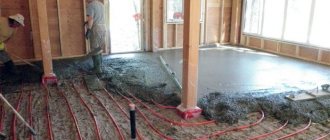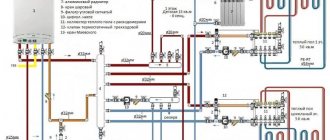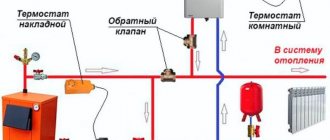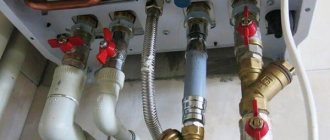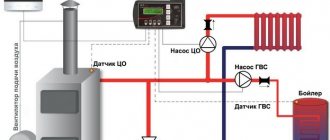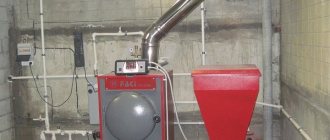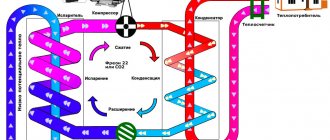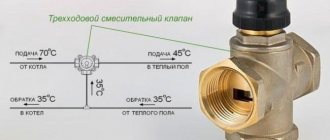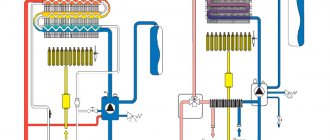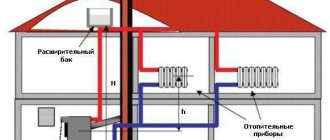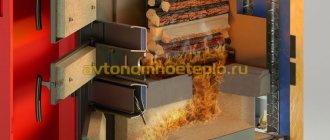Homeowners who have installed a solid fuel boiler are faced with two characteristic problems over time. During prolonged use, either the heating device overheats or condensation accumulates. The first problem is fraught with a serious accident, including the explosion of system elements, the second - with damage to the walls of the furnace. In both cases, expensive repairs will be required.
However, serious breakdowns and other troubles can be easily avoided. For this purpose, the boiler is protected from overheating and condensation. We will tell you what it is and how it works in this article.
Causes of problems
Boiling of the coolant in systems with solid fuel boilers occurs for the following reasons:
- an air damper that controls the chain traction regulator is not completely closed;
- fluctuations in the supply of electrical energy;
- ECU malfunction, due to which the discharge regulator is turned off;
- a malfunction of the mechanical thermostat, due to which the air supply door may not close.
Condensation in the system occurs for other reasons. The water in the heating system is initially at room temperature. When the boiler is ignited, the latter rises locally and sharply, causing condensation to occur. It mixes with smoke and settles on the inner surface of the boiler. The crust formed when the walls are regularly “enveloped” in a mixture of smoke and condensation can be so thick that modern anti-corrosion agents will not help.
You can avoid boiler overheating. To completely eliminate the appearance of condensation - no, only to significantly minimize it. Let's look at how solid fuel boilers are protected from overheating.
Connection diagram of a solid fuel boiler to the heating system
Main features of a heating system with a solid fuel boiler:
- The temperature on the boiler supply line should be 80-90°C.
- It is recommended to install Laddomat 21/20 or a thermal valve with a pump in the boiler circuit so that the temperature in the boiler return line is not lower than 65°C. This will prevent condensation of acids and resins and will extend the life of the boiler.
- The boiler circuit pump must be controlled by a separate thermostat at a temperature of 70 - 80°C. The circulation pump of the heating system must operate simultaneously with the boiler pump. This is necessary to prevent the boiler from cooling through the return line. This does not apply to cases where the system has a heat accumulator. In this case, the cold coolant will flow into it and not into the boiler.
- It is necessary to provide protection for the boiler from overheating when the power supply is turned off, since it is not possible to immediately stop the combustion of fuel.
- It is not recommended to operate the boiler at reduced power for a long time, as this will cause the formation of tar and acids, which causes corrosion of the boiler and shortens its service life.
- The boiler must be installed in a dry and well-ventilated area. There must be enough space around the boiler to walk around it.
- The boiler chimney must be well insulated to avoid the formation of condensation, as well as increased formation of soot and resins.
- The chimney must provide sufficient draft as prescribed by the boiler manufacturer (indicated in the passport). If the draft is less than required, more tar and tar are formed, the service life of the boiler and its performance are reduced, and smoke may enter the room. In this case, it is recommended to increase the chimney, or reduce its cross-section (a liner in the pipe), or install a deflector or exhaust fan.
- If the draft is greater than required, the efficiency of the boiler decreases (heat literally flies out into the chimney) and more fuel is consumed. To reduce the draft, a throttle valve is installed at the boiler outlet.
How to protect the boiler from overheating? Options:
- Install Laddomat 21/20.
- Install a protective circuit against overheating with a valve in the boiler and connect it to the water supply.
- Install an uninterruptible power supply (UPS) and connect the circulation pump to it.
- Install one additional circuit with a radiator, operating on the principle of natural circulation. You can place it, for example, in a boiler room.
| Overheat protection valve WATTS STS 20 | Overheat protection valve Regulus DBV 1 | Regulus DBV 1 valve connection diagram |
The optimal option for connecting a solid fuel boiler is with a buffer tank (heat accumulator). If it is not possible to install a full-fledged heat accumulator with a design capacity, then even a small 500 liter battery will be very useful for your heating system.
Connection diagram for a solid fuel boiler with several heat accumulators:
What are the advantages of having a heat accumulator in a heating system with a solid fuel boiler:
- The boiler can operate at full power until the fuel is completely burned, which increases its efficiency and saves up to 40% of fuel during the heating season.
- Optimal fuel combustion - minimal formation of tar and tar - long service life of the boiler and chimney.
- Possibility of combining different heating sources: heat pump, solar collector, electric heating with heat accumulation at night tariff.
- Comfortable heating: the period between loads increases.
- It is not possible to heat the boiler every day in the off-season.
How to prevent coolant from boiling
Stable operation of the automation and security system guarantees reliable operation of the boiler. If a temperature sensor or mechanical thermostat fails during operation, a sharp jump in temperature occurs.
There are three ways to prevent this:
- Supplement the system with an electric generator or other power source.
- Introduce a two-way safety valve.
- Install an emergency bypass with a buffer tank.
The introduction of an additional power source, although an expensive method, is popular and fully justified. Moreover, modern boilers are often equipped with similar systems.
Is it necessary to spend money on an assistive device? A far-sighted user will always take care of having an emergency generator to ensure the system's energy independence or, at a minimum, buy an uninterruptible power supply unit.
Two other methods of protecting solid fuel boilers from overheating deserve a more detailed analysis.
Water heater protection from overheating
All modern water heaters sold in the online store of the StroyObjectSnab Trading House are equipped with a system to protect the equipment from overheating. Special sensors monitor critical temperature rises, and the automation turns off the boiler. In addition, systems are installed that protect against changes in cold water pressure. When the pressure drops critically, the protection turns off the water heater to prevent further overheating. Of course, you must remember that you should turn on the storage water heater with the cold water supply valve open.
Our company provides comprehensive services for water heater selection, installation and commissioning. The employees of the StroyObjectSnab Trading House have extensive experience in practical work with water heating equipment.
Safety valve installation
This device should not be confused with its safety analogue. The latter only relieves excess pressure in the system, while the protective one stabilizes the temperature of the coolant. If there is too much hot water, it is withdrawn and replaced with cold water.
The safety valve is a non-volatile device that is connected to several components: sewerage, water supply, direct and return lines. The operating principle is as follows:
- when the coolant reaches a temperature of 105 °C, the valve opens;
- hot water is forced out of the water jacket using a pressure of 3-5 bar;
- excess liquid goes down the drain;
- By forced or natural circulation, a new cool liquid comes to replace the removed liquid and gradually warms up.
Such protection of a solid fuel boiler is most often effective, but there are exceptions. Thus, this method is unacceptable for systems in which a combination of distilled water and antifreeze liquid (antifreeze) is used as a coolant. Also, implementing a circuit with a safety valve is impossible in a centralized water supply system, since when the power is turned off, the water supply from the main well or reservoir immediately stops.
Emergency bypass
A bypass is a jumper installed on the heating route parallel to the main line. It is a bypass or direct section connecting the direct highway with the return one.
In the case of solid fuel boilers, the emergency jumper is installed bypass around the circulation pump. During operation, it slightly presses the petal of the check valve, as a result, the coolant does not pass through the bypass. If there is a sudden power outage, power surge or overheating, the pump will stop and the valve will close. As a result, the flow will flow through the jumper. Once the system is restored, the valve will open again.
For the above scheme to work correctly, three conditions must be met:
- the system provides a buffer or large-volume heat accumulator (excess liquid will be discharged here);
- the mains are made of steel pipes with a large diameter and are located at a slope sufficient for natural circulation;
- The petal type check valve is mounted strictly horizontally.
Now let's talk about the second well-known problem in the operation of solid fuel boilers and ways to solve it.
Different boilers - different consequences
Cooling down at home is not the main danger. After all, serious cooling of a home requires 3-5 days, depending on the quality of thermal insulation, heated area, outside temperature and other circumstances. There will probably be electricity by this time. Except for serious accidents.
Such shutdowns cause more harm to the boilers themselves. And not everyone. Let's consider the consequences for different types of aggregates.
- Electrical.
For them, a power outage is the least dangerous. They simply turn off, and when the power supply is restored, they resume normal operation. As a rule, there are no consequences. - Liquid fuel.
Usually there are no special consequences for them either. When the light goes out, the fuel pump simply stops working. The fuel does not flow to the burner, its remains are used, after which the flame goes out. But in some situations this leads to heat exchanger breakdowns. The reason is severe overheating of the liquid in it. The situation is relatively rare, but it does occur. - Gas.
Here the consequences are more serious. The fact is that gas is supplied regardless of the availability of energy. Without electricity, the automation does not work, but the fuel continues to flow to the burner and burn. At the same time, circulation pumps, temperature sensors, and flame sensors also do not work. At this time, the liquid, upon entering the combustion chamber, rapidly heats up and can be brought to a boil. Starting reverse ignition without electricity is impossible, and therefore the gas supplied to the burner begins to gradually leak out into the premises. These leaks can be quite profuse. In ventilation boilers with closed chambers, gas leaks into the room are excluded. But here the gas goes into the chimney, which is also bad. - Solid fuel.
They are the most sensitive to blackouts. However, most often non-volatile units are used, for which interruption of the electricity supply does not play any role. Otherwise, the consequences are critical. The owner cannot extinguish the flame by turning off the fuel supply, as in other boilers. Even if you close the damper. It is prohibited to extinguish fire with water. The consequence is that, at a minimum, the heat exchanger fails. But there can be negative consequences for the entire system.
Condensation protection
Plaque deposited on the internal walls accelerates the wear of the boiler and shortens its service life. Accumulating moisture has less impact on cast iron, since it is not susceptible to corrosion.
One way to protect the boiler from condensation is to introduce a three-way thermostatic valve. It is adjusted to a coolant temperature of about 55-60 °C and operates as follows:
- while the water is heated to a given temperature, it circulates through a small circuit of the system;
- when the specified value is reached, the valve mixes water into the main circuit;
- the risk of sudden temperature changes is eliminated, condensation does not appear in the firebox.
It is not always necessary to separately purchase and install a three-way valve - some manufacturers implement devices with similar functions in their products. However, if necessary, you can purchase such mixing units for 20-30 thousand rubles.
About three way valve
The device comes in two types:
- distribution;
- mixing
The first is installed on the supply pipeline, the second on the return pipeline. The valve's job is to regulate not only temperature, but also fluid flow. The device never closes or opens it completely. The valve itself is closed only when the boiler is started.
The mixing and distribution valves are non-volatile. They do not require additional devices or controllers. Heating of the coolant on a small circle is completed in 15-20 minutes. Sometimes an hour is not enough to warm up the water in the entire system.
The cost of a thermostatic valve is from 5 to 7 thousand rubles. Even taking into account installation costs, this is more profitable than buying a mixing unit. Moreover, the valve provides the same effective removal of condensate.
The occurrence of condensation or overheating can be minimized at the system design stage. This applies, for example, when choosing pipes from a certain material.
Polymer products are more susceptible to high heat. It is better to wire the heater with copper or steel, and attach polypropylene elements to the distribution manifold. The presence of a metal pipe in the “return” section between the three-way valve and the boiler pipe is of particular importance - the temperature sensor on the polymer will react to overheating with a delay.
